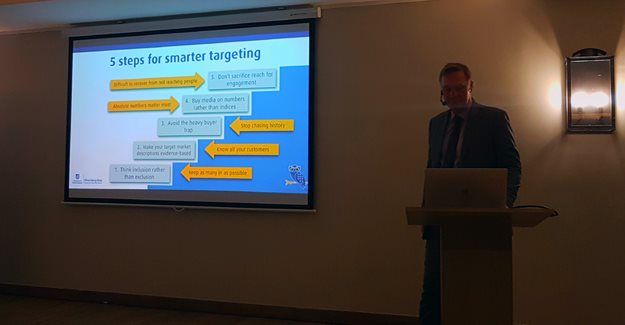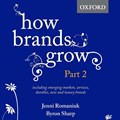Subscribe & Follow
Trending
Jobs
- Marketing Coordinator Hazyview
- Marketing Agent Nelspruit
- Innovative Sales Consultant Nelspruit
- Junior Graphic Designer and Marketing Assistant Johannesburg
- Marketing Analyst Nelspruit
- Digital Marketing Assistant Cape Town
- Sales Assistant Nelspruit
- Junior Sales Marketer Mbombela
- Digital Marketing Account Manager Centurion
- Sales Associate Nelspruit
5 steps to becoming a smarter target marketer

Explaining his five steps to becoming a smarter target marketer, Driesener said it's a commonsensical process, once you understand the reasoning…
1. Be inclusive rather than exclusive
Driesener says to ‘think bigger’ about who your potential customer is, rather than smaller, and wider rather than narrower and to ensure your target market descriptions are evidence-based.
Focus on who is actually buying the category, as it’s the category buyer we care about.
To illustrate this, Driesener showed an example from Burger King Australia – known there as “Hungry Jacks” aimed to sell more burgers to their existing customer base, who buy them more than 9 times in a month. That’s a heavy buyer.
The brand changed the advertising message and the product offering specifically to the audience, going so far as to reduce physical availability by closing down some stores as to where that heavy audience wasn’t prevalent.
Driesener says the ad definitely grabs your attention, but it’s definitely exclusive in saying, “Ladies, this is not for you, this is a man’s burger.”
Ironically, competitor McDonald’s benefited from the campaign as they continued selling to everyone. Burger King followed suit in 2001 when it turned things around with a change of CEO and campaign messaging, bringing in salads and coffees to their offering to widened their target and recover some lost ground.
Driesener cautions that when you target, you’re making a choice about who won’t buy your products – rather leave that up to the consumer, don’t make the decision for them, and remember that it’s often not a rational decision.
The response we care about ultimately is in selling more product, so if I limit who I talk to, I’ve got to get a bigger response out of them to hit a certain target.
Rejection rates are only at about 5% to 10% of the non-buying population, which means the bulk of people who haven’t bought your product before have no particular reason not to do so in future.
It’s just that they didn’t think about you at the right time, or have another brand linked to that particular category entry point already, or perhaps they did think about you but your product wasn’t available.To determine how successful targeting had been over time, brand user profiles of competing brands were compared, to see how different the users actually are. Driesener explains that in a segmented targeted world where that works well, you should see quite big differences in the audience or customer base.
More often than not, there’s not a whole lot of difference between the users of the competing brands.
Driesener says the reason is simple: As soon as you have repertoire buying, the same person is counted in multiple brand user profiles.
That’s why he says to profile the category, to better understand the category user as it’s not just about your particular brand’s customers, but everyone who buys the product category.
Thinking ‘inclusion rather than exclusion’ means being aware of groups you’ve deliberately chosen to exclude from your customer base and whether you’re accidentally excluding others through a focus on limited resources or media types.
2. Make your target descriptions evidence-based
When thinking who your target market is, Driesener says to look at the evidence of who is actually buying the category. Beer ads tend to largely feature men and in Australia, 80% of the category buyers are male, which shifts to 70/30 globally.
Driesener says you could argue that globally, the beer category has done a good job of targeting men, or rather that they’ve done a terrible job of talking to women.
This links back to the point of inclusion and exclusion, so Driesener says to be aware of advertising that reflects stereotypes as lots companies unthinkingly perpetuate this.
Look at both your potential customers and the actual data of who is buying the category, rather than relying on your own prejudices.
Make sure you can describe your light users and that you include them in your descriptions too, not just your heavy users.
Maybe the reason they don’t buy your brand often is that you don’t encourage them to think about your brand, which becomes a self-fulfilling prophesy.Driesener adds that the more you limit your offering to a particular group of people, the more you limit your potential to sell to and recruit new customers.
3. Avoid the heavy buyer trap
It’s easy to stuck focusing on yesterday’s successes, but the brand’s performance metric relies on customer base and loyalty as the distribution of purchase probabilities across a population.
The good news is that there is a probability of everyone buying you, but it’s your job as a marketer to nudge those probabilities for as many people as you can, not just the heavy buyers.
Andrew Ehrenberg’s work in 1959 discovered the implacability of distribution to purchasing and still holds true today. We expect to see the negative binomial distribution or NBD model when we plot buying patterns, with Driesener saying some say ‘No Brand is Different’ – brands have lots of light customers and few heavy customers, so most of your customer base will skew light, no matter the brand.
How we make decisions and the physiological mechanisms behind that decision-making framework are the same for all of us, it’s just the context that changes.
Some counter the NBD model by mentioning the Pareto principle, but Driesener offers a wake-up call – 20% of your customers usually don’t contribute 80% of your sales. The top 20% of your customers are more likely to contribute 50% to 60% of your sales, which means if you’re purely focusing on your heavy buyers, you’re ignoring 40% to 50% of where your sales come from.
Even in an 80/20 world, you still need to think about the light buyers.
Driesener says regardless of what you do, there’s constant underlying churn in your customer base, which is why you need to nudge all your existing and not-yet customers and remind them that you exist and to buy your product so that they think of you in that decision-making moment.
Heavy buyers will notice all your campaigns so you don’t have to specifically target them, nor should you go for subtle branding that light customers will miss, as they’re not as sensitised to your branding.
That’s why all your communications need to be clearly branded to maximise the mental and physical availability context, as it’s what enables someone to reach out and pop your product in their trolley.
Driesener adds that heavy buyers already buy your brand often so it’s hard to get more sales from them. There also tend to be more of light than heavy buyers, so that’s who you should focus your campaigns on. There will also be a vast number of ultra-light buyers, who only buy your product every two or three years.
Ask yourself how much of your marketing effort are you preaching to the converted…
4. Buy media on absolute reach
Driesener’s fourth point is to buy media on the numbers rather than the audience skews.
He adds that people inside media organisations are sharp, so the more you worry about targeting and the more important you think it is, the more they’ll offer highly targeted services for you and claim their media is specifically targeted to particular audiences, as a result of the skews inside their base.
Often it’s a case of overpromising on the difference in their audience against other competing media and underdelivering on that audience if you pick just one targeted offering from the menu.
That said, Driesener adds that some of marketers’ worst efforts have been rescued by the fact that media save them from themselves in delivering audiences outside their target as we tend to focus on too narrowly defined buyer groups.
The narrower the proposition is, the less of an actual audience that proposition represents, which is a wastage issue. You’re paying a premium for that target, but what are you actually getting for it? That’s why Driesener comes back to the point to always check the raw numbers.
In 1998, Erwin Ephron said: ‘I have a nagging feeling that traditional targeting has been overvalued by media for a very long time. A brand can reach more of its target by targeting less.’ But today’s social media world promises something vastly different.The fabulous claim is that we can offer a highly targeted audience, but is that what we really want? Nielsen’s work on different social media targets, where a narrow example had an age range of less than 20 years, found the narrower the target was on social media, the less impressions were delivered into that particular target.
Conversely, the broader the target, the more impressions were delivered. That’s why Driesener proposes that wider targets actually mean less wastage.
Online and social media certainly offer more targeting options but bear in mind that their ability to deliver on those can be vastly overrated, as there’s also a danger of excess frequency.
Programmatic buying services’ capacity to deliver particular audiences have also been researched, and with a male-female split, the male consumer is only identified half the time.
“Marketing Automation” - new cartoon and post on what makes marketing effective https://t.co/7Xr6JLQ4Gi#marketing #automation #cartoon pic.twitter.com/RWWOZ0BPgz
— Tom Fishburne (@tomfishburne) July 28, 2019
Driesener said that ultimately, you reach more by targeting less, as well as by putting bigger media first to get the most bang for your buck and filling in the gaps afterwards.
It’s about buying media on absolute reach rather than on indices and worrying less about audience skews, more about how much of the audience the particular media reaches.
So question your media-buying decisions and whether you know how many people you actually reach.
5. Don’t sacrifice reach for engagement
Explaining his final point, Driesener says we get caught up in the idea of running engagement campaigns to get people really interested, but the problem with doing lots of those is that you talk more to talk to fewer people.
Limited resources mean lots of money is spent on building high engagement, but that shouldn’t mean sacrificing reach to do so.
Today, everyone wants to “engage with millennials,” but are they the right target for our product?
Driesener echoes his earlier point that marketers need to engage everyone. The world has completely changed and people in turn change what they buy and what they want, often on a whim.
Sadly, marketing remains a relatively weak force that at best nudges consumer a little bit.
Driesener cautions against being too demanding in this regard as you’re likely driving your consumers nuts. They buy from you occasionally, and buy from other brands, with true ‘brand love’ rarely seen.
To prove this, Driesener said we all have a few brands we really love across different categories, but if we go home and look through our wardrobes, kitchens and garages we’ll see lots of what we don’t love, yet still handed over good money for.
That’s why Driesener advises against aiming for brand love in your customers, and rather get them to think about your brand a little bit more than they think about the competition, in the little bit of time they spend thinking about your category.
Marketing is an ongoing battle that never stops unless our competition stops, so there’s a massive opportunity cost in a lack of reach. The consumers you don’t reach have no opportunity to be affected by your marketing campaign, but just because you’re not reaching them, doesn’t mean your competitors aren’t either.
You don’t want to leave the battlefield open to them, so don’t sacrifice reach for engagement. Rather focus on the scalability of those engagement opportunities because ultimately, we all want to work smarter, not harder.
Driesener concludes that we need to worry less about targeting and think more about our overall category buyers rather than getting caught up in micro-targeting small little groups.
Instead, target the market, target everyone in the category.In some categories you have the opportunity to only sell once, which means you need to keep looking for new customers.
That’s why your media objective should be to reach as many people as you can throughout the year. Follow seasonal peaks, but remember that continuity also matters.
Driesener also debunked one of the biggest targeting myths – “Customers buy exclusively from specific brands to the exclusion of all others”. But that’s not supported by the evidence.
There are often little skews, as people who buy high-price brands are less likely to buy low-price brands and vice versa, while people who buy the mid-price brands tend to buy both up and down.
Smart targeting recognises that the same customer can have multiple reasons for being in the category, so sell to the category buyer for the best results.
The higher the hurdle, the fewer consumers jump…
Build mental and physical availability, making the brand easier to find out so that it jumps out on the shelf on the front page of Google as hardly anyone scrolls beyond that.
Are you available where people want you, do you understand the channels people follow in the category? Do you have the right product in those channels? Are you wearing your puffer jacket both in the campaign and on the shelf? That’s how people will recognise it and find you in the buying situation. That’s what really matters.


































